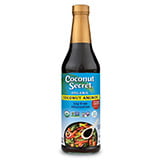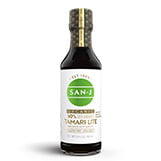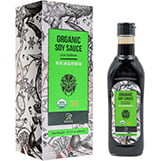- Best For Anyone With Food Allergies | Ocean's Halo | Find on Amazon
- Best Shoyu Soy Sauce | Eden Foods | Find on Amazon
- Best Ponzu Sauce | Eden Foods | Find on Amazon
- Best Teriyaki Sauce | Big Tree Farms | Find on iHerb
Soy sauce is a beloved condiment worldwide. This humble sauce may seem simple, but its complex flavor profile and versatility in the kitchen make it a true superstar ingredient. Whether you are marinating meats, enhancing stir-fries, or simply dipping your sushi, soy sauce adds a depth of umami flavor that elevates any dish.
While soy sauce is a flavorful and versatile condiment, it may not be healthy in large quantities due to its high sodium content. Most brands of soy sauce contain around 1000 mg of sodium per tablespoon, which is approximately half of the recommended daily intake for adults.
In this guide, we'll highlight a few of the best soy sauces that are healthier and gluten-free soy sauce alternatives to add to your cooking routine.
The 7 Best Soy Sauce And Soy Sauce Alternatives To Add To Your Pantry
Coconut Secret Coconut Aminos
Best Soy Free
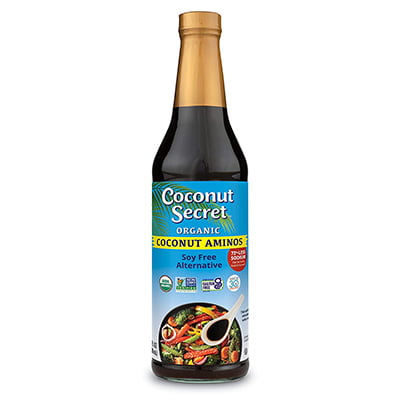
Source: Amazon
Coconut Secret Coconut Aminos is the perfect addition to any pantry for those looking for a healthier, soy-free alternative to traditional soy sauce. Made from the sap of the coconut tree that is naturally aged to develop its rich and savory flavor, this delectable condiment adds versatility and an explosion of flavors to your preferred dishes, making it a perfect ingredient to add depth and complexity.
In addition, this coconut amino is one of my favorites because it contains less sugar and sodium content than other popular brands like Bragg Organic Liquid Coconut Aminos, Kevala Organic Coconut Aminos, Big Tree Farms Coco Aminos Seasoning Sauce, and Thrive Market Organic Coconut Amino. Each serving size is one tablespoon, and each serving contains 270 mg of sodium and 3 g of sugar. This option is significantly lower than the sodium content of traditional soy sauce. Whether you're stir-frying veggies, fried rice, marinating meats, or simply looking for a delicious dip for your sushi, this coconut aminos is a perfect choice.
Our Ratings
Overall Rating: 4.7/5 Saltiness Level: 2.7/5 Taste: 4.8/5 Value for Money: 4.8/5
Sodium Level | 270 mg per tablespoon |
Added Sugar | 3 g per tablespoon |
Plastic or Glass Bottle | Glass |
Gluten Free Friendly | Yes |
Pros:
Cons:
San J International Organic Tamari Lite
Best Tamari soy sauce
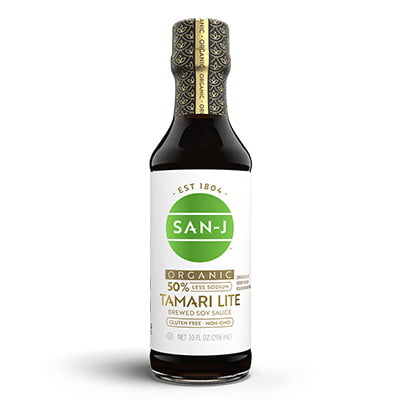
Source: San-J
San-J Organic Tamari Lite Soy Sauce is the perfect addition to any pantry for those looking for a healthier, low-sodium alternative to traditional soy sauce. Made from 100% whole soybeans, this delicious condiment is a versatile and flavorful way to add depth and complexity to your favorite dishes. With its full-bodied flavor, this tamari sauce is an excellent substitute for darker soy sauce.
What we love about this product is that Organic Tamari Lite is organic, vegan, gluten-free certified, non-GMO verified, and contains 50% less sodium than traditional soy sauce, making it a healthier option for you and your family. With 470 mg of sodium per tablespoon, this tamari sauce contains less sodium than traditional soy sauce. Whether you're stir-frying veggies, marinating meats, or simply looking for a delicious dip for your sushi, San-J Organic Tamari Lite Soy Sauce is a perfect choice.
Our Ratings
Overall Rating: 4.7/5 Saltiness Level: 4.7/5 Taste: 4.6/5 Value for Money: 4.7/5
Sodium Level | 470 mg per tablespoon |
Added Sugar | 0 |
Plastic or Glass Bottle | Glass |
Gluten Free Friendly | Yes |
Pros:
Cons:
Soeos Organic Low Sodium Soy Sauce
Most Budget-friendly
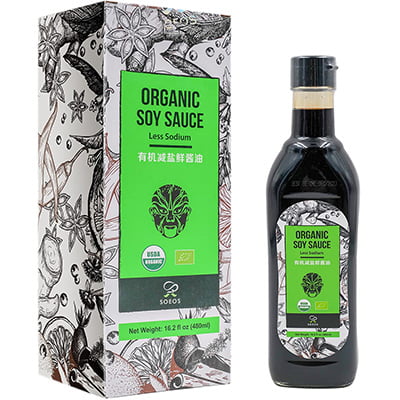
Source: Amazon
Soeos Organic Low Sodium Soy Sauce is the perfect condiment for those who love the taste of soy sauce but want to reduce their sodium intake. This dark soy sauce comes in a large glass bottle, and the price per ounce is much less than some other soy sauces on the market.
Made from organic soybeans, wheat, and salt, this delicious soy sauce is naturally brewed and has less sodium than traditional soy sauce. This condiment is made from organic soybeans and organic wheat. It is naturally brewed without any added artificial additives, preservatives, or fillers, making it a healthier option compared to other condiments available in the market.
With this low-sodium soy sauce, you can enjoy the same salty-sweet flavor without the excess salt. It's a great option for health-conscious people who don't want to sacrifice flavor or umami. Whether you're using it in a marinade, stir-fry, dressing, or any other recipe that calls for soy sauce, this low-sodium version will provide the same delicious taste with the added benefit of being healthier for you.
Our Ratings
Overall Rating: 4.6/5 Saltiness Level: 5/5 Taste: 4.8/5 Value for Money: 4.6/5
Sodium Level | 704 mg per tablespoon |
Added Sugar | 0.7 g per tablespoon |
Plastic or Glass Bottle | Glass |
Gluten Free Friendly | No |
Pros:
Cons:
Ocean's Halo Organic Soy-Free No Soy Sauce
Best For Anyone With Food Allergies
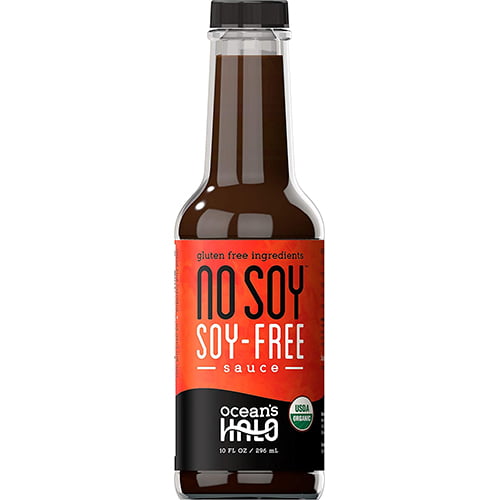
Source: Amazon
Looking for a mushroom soy sauce alternative that's both soy-free and gluten-free? Look no further than this all-purpose sauce from Ocean's Halo. The all-purpose sauce perfectly replaces conventional soy sauce in dips, marinades, stir-fry, and Asian recipes. It gets its umami flavor from a unique combination of apple cider vinegar, kelp, mushrooms, molasses, and citrus. The best part is it's gluten-free, vegan, soy-free, MSG-free, and USDA-certified organic.
Unlike other products, No-Soy Soy-Free Sauce is made with sustainable ingredients and no artificial flavors or preservatives. It is organic and vegan certified. This product is also soy-free, gluten-free, and made from non-GMO ingredients. This soy sauce is perfect for anyone with soy allergies or dietary restrictions. Each serving contains 660 mg of sodium and 1 g of sugar per tablespoon. The low sodium option is available at 310 mg of sodium and 1 g of sugar per tablespoon.
Oceans Halo Organic No Soy Sauce and coconut aminos are both soy sauce alternatives that offer similar taste profiles without using soybeans. Nevertheless, there are some distinctions between the two, and ultimately, the choice comes down to personal preference based on individual taste buds. Coconut amino tastes sweet and salty, while Oceans Halo Organic No Soy Sauce has a rich and savory flavor. Coconut aminos are made from the sap of coconut blossoms, while Oceans Halo Organic No Soy Sauce is kelp-based. When choosing between Oceans Halo Organic No Soy Sauce and coconut aminos, it ultimately comes down to personal preference.
Our Ratings
Overall Rating: 4.5/5 Saltiness Level: 5/5 Taste: 4.6/5 Value for Money: 4.4/5
Sodium Level | 660 mg per tablespoon |
Added Sugar | 1 mg per tablespoon |
Plastic or Glass Bottle | Glass |
Gluten Free Friendly | Yes |
Pros:
Cons:
Eden Foods Organic Shoyu Soy Sauce
Best Shoyu Soy Sauce
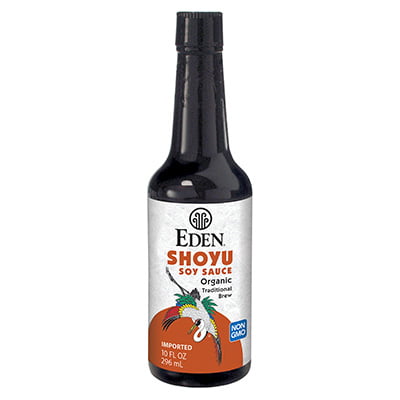
Source: Eden Foods
Eden Foods Organic Shoyu Soy Sauce is the perfect condiment for those who love soy sauce's rich and savory taste. Expertly crafted using the traditional brewing method by skilled brew masters, this soy sauce has been carefully aged in stainless steel vats for two years. This slow and meticulous process allows the flavors to meld together, creating a sauce that brightens and enhances any dish's character depth. Made with organic whole soybeans, wheat, and sea salt, this delicious soy sauce is brewed traditionally for up to two years, giving it a complex and robust flavor.
EDEN Shoyu Soy Sauce is packaged in amber glass bottles to preserve its deep color, fragrant aroma, and rich character. Each bottle has a functional dispenser cap that allows you to control the amount of sauce you pour or drip, providing you with the perfect amount for any dish.
When it comes to sodium, EDEN Shoyu Soy Sauce contains 880 mg of sodium per tablespoon. While this is still significant, it is lower than popular soy sauces like Kikkoman Soy Sauce and 365 by Whole Foods Market Shoyu Soy.
Our Ratings
Overall Rating: 4.7/5 Saltiness Level: 4.8/5 Taste: 4.8/5 Value for Money: 4.6/5
Sodium Level | 880 mg |
Added Sugar | 0 |
Plastic or Glass Bottle | Glass |
Gluten Free Friendly | No |
Pros:
Cons:
Eden Foods Ponzu Sauce
Best Ponzu Sauce
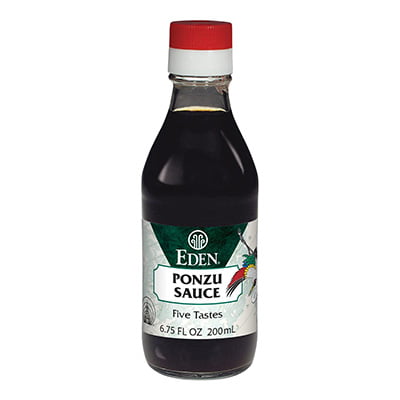
Source: Amazon
If you want a more complex umami flavor, try Ponzu sauce instead! The delicious Asian sauce blends shoyu soy sauce and rice vinegar with citrus juices to create a unique taste that's salty, sweet, sour, tangy, and savory all in one. Traditionally, ponzu sauce is used as a dipping sauce, marinade, salad dressing, shrimp soy sauce, and adding a finishing touch to stir-fry dishes.
If you've never tried the tasty condiment before, starting with Eden Foods' Ponzu Sauce, you can't go wrong. It's made without artificial colors, flavors, preservatives, and chemical additives, so you can enjoy all the sparkling flavors without any guilt. Unlike regular soy sauce and the other alternatives, each tablespoon contains 340 mg of sodium. This Eden Foods' Ponzu Sauce is a great alternative to traditional soy sauce, offering a unique and delicious flavor profile that will satisfy your taste buds.
Our Ratings
Overall Rating: 4.6/5 Saltiness Level: 3.4/5 Taste: 4.6/5 Value for Money: 4.5/5
Sodium Level | 340 mg per tablespoon |
Added Sugar | < 1 g per tablespoon |
Plastic or Glass Bottle | Glass |
Gluten Free Friendly | No |
Pros:
Cons:
Big Tree Farms Organic Teriyaki Coconut Aminos
Best Teriyaki Sauce
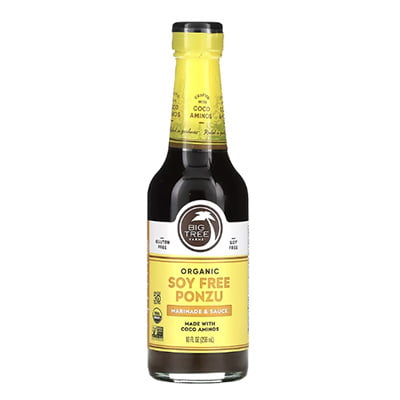
Source: iHerb
Big Tree Farms Teriyaki is a premium, organic marinade that packs a punch of savory flavors into any dish. This versatile and organic sauce is a perfect blend of sweet and savory flavors with a hint of umami. It is made from simple, natural ingredients, including organic coconut aminos, raisin juice concentrate, sesame oil, and ginger extract. This soy-free teriyaki sauce is gluten-free, soy-free, and refined sugar-free. It is vegan and paleo-friendly. It is also Whole 30 approved, organic certified, non-GMO verified, and meets Control Union Fair Choice Social and Fair Trade Standards.
Carefully crafted in small batches from Indonesia to ensure that each bottle meets the highest standards, Big Tree Farms Teriyaki features a sweet and savory flavor with soulful sesame and a kick of ginger. The result is a rich and flavorful marinade that can enhance the taste of a wide range of dishes, from marinating grilled meat and vegetables to stir-frying. With 460 mg of sodium and 6 g of added sugar per tablespoon, this sauce can elevate your cooking game to the next level.
Our Ratings
Overall Rating: 4.6/5 Saltiness Level: 4.6/5 Taste: 4.6/5 Value for Money: 4.8/5
Sodium Level | 460 mg per tablespoon |
Added Sugar | 6 g per tablespoon |
Plastic or Glass Bottle | Glass |
Gluten Free Friendly | yes |
Pros:
Cons:
What To Look For When Shopping For Soy Sauce
Type of soy sauce
There are different types of naturally brewed soy sauce, and each has unique characteristics and culinary uses.
The most common type is light soy sauce, which is thinner, lighter in color, and saltier. This makes it ideal for seasoning dishes without significantly altering their color. It's commonly used in stir-fries, marinades, and as a dipping sauce.
Dark soy sauce is thicker, darker, and less salty but sweeter than light soy sauce. It's often used in braising, adding color and a rich flavor to dishes like stews and red-cooked meats.
Tamari, a Japanese variant, is made almost exclusively from soybeans, which gives it a richer flavor and makes it a popular choice for those avoiding wheat and gluten.
Another variety, sweet soy sauce, known as kecap manis, is thick and sweet and used predominantly in Indonesian cuisine to add a sweet depth to dishes like nasi goreng and satay.
Origin
You will also need to consider whether it's Chinese, Japanese, or Korean soy sauce, as each type has a different taste.
Chinese Soy Sauces
Chinese soy sauce is made from soybeans, wheat, salt, and water. It is typically fermented for a shorter period than Japanese soy sauce, resulting in a lighter and saltier flavor. Ranges from light to dark, Chinese soy sauces are often used in stir-fries, marinades, and dipping sauces.
Chinese light soy sauce has a lighter color and a saltier taste than dark soy sauce. It is often used as a seasoning or marinade for seafood, stir-fries, and vegetable dishes. Light soy sauce is also commonly used as a dipping sauce or condiment, either on its own or mixed with other ingredients such as vinegar or chili oil.
Chinese dark soy sauce, on the other hand, is made with more soybeans and less wheat than light soy sauce. It is fermented longer and has a darker color, thicker consistency, and sweeter, more complex flavor. Dark soy sauce is often used to add color and depth to dishes and is commonly used in braises, stews, and sauces.
Japanese Soy Sauces
Japanese soy sauce, or Shoyu and soya sauce, is also made from soybeans, wheat, salt, and water, but it is typically fermented longer than Chinese soy sauce, giving it a deeper, more complex flavor. Japanese soy sauce comes in different types: Koikuchi, Tamari, Saishikomi, Usukuchi, and Shiro (white soy sauce).
Korean Soy Sauces
Korean soy sauce, or Ganjang, is made from soybeans, wheat, and salt, but it is typically fermented for a much longer period than Chinese or Japanese soy sauce, giving it a rich, savory flavor. Korean soy sauce comes in different types: Joseon Ganjang, Guk-ganjang (soup soy sauce), Yangjo Ganjang, Jin Ganjang, and Saeng Ganjang. Korean soy sauce is often used in stews, soups, and marinades and is an essential ingredient in many Korean dishes.
Thai Soy Sauces
Thai soy sauce, also known as si-ew Thai, is a type of soy sauce that is commonly used in Thai cuisine. Although Thai soy sauce is also made from fermented soybeans, wheat, salt, and water like its Chinese and Japanese counterparts, it has a unique flavor profile that distinguishes it from the others. One key difference is that Thai soy sauce often contains additional ingredients such as palm sugar, molasses, and tamarind, which give it a slightly sweeter and tangier taste than Chinese or Japanese soy sauce. Additionally, Thai soy sauce is often made with a higher ratio of fermented soybeans to wheat than other types of soy sauce, resulting in a darker color and richer flavor.
Sodium content
Soy sauce is a salty condiment whose sodium content can vary between brands. If you're watching your sodium intake, look for low-sodium or reduced-sodium soy sauce or use less soy sauce in your recipes.
Ingredients
Check the ingredients list for any additives or preservatives that you may want to avoid. Some brands may include additives like MSG or artificial coloring, so look for brands that use natural ingredients.
Opt For Organic Soy Sauce
Did you know that nearly all soybeans grown in America are genetically modified? That's right. The FDA reports that GMO soybeans make up 94% of all soybeans planted in 2018. Though studies have drawn several contradicting conclusions, the true health effects of genetically modified crops are still relatively unknown.
Additionally, soy is one of the most common allergens, especially among children, where rates have increased substantially over the past two decades. Food scientists have recently begun to find evidence of a correlation between the prevalence of GMO foods and the increase in children with food allergies. For these reasons, it's best to stick to high-quality, organic, naturally-brewed products from reputable companies. If you're worried about soy sauce's potential adverse health effects, use a soy sauce alternative like tamari or liquid coconut aminos instead.
Fermentation Length
Fermentation is a crucial step in the production of soy sauce, as it helps develop the sauce's unique flavor and aroma. The longer the fermentation period, the richer and more complex the soy sauce flavor. Typically, soy sauce can be fermented anywhere from a few months to several years, depending on the desired flavor profile.
If you're looking for a soy sauce with a richer, more complex flavor, you may want to look for options that have been fermented for a longer period. However, remember that longer fermentation periods can also result in higher sodium content, so be sure to check the nutrition label if you are watching your sodium intake.
Price
Soy sauce prices can vary widely depending on the brand, type, and quality. It's not always necessary to opt for the most expensive soy sauce, but be cautious of very cheap options as they may not be of good quality or may contain additives.
How We Picked
Our soy sauce selection has been meticulously chosen, taking into consideration our personal experiences, extensive research of customer feedback across various retail platforms, and valuable insights from home chefs. We've prioritized key factors such as sodium levels, use of organic ingredients, and taste to ensure our soy sauce picks meet the highest standards.

